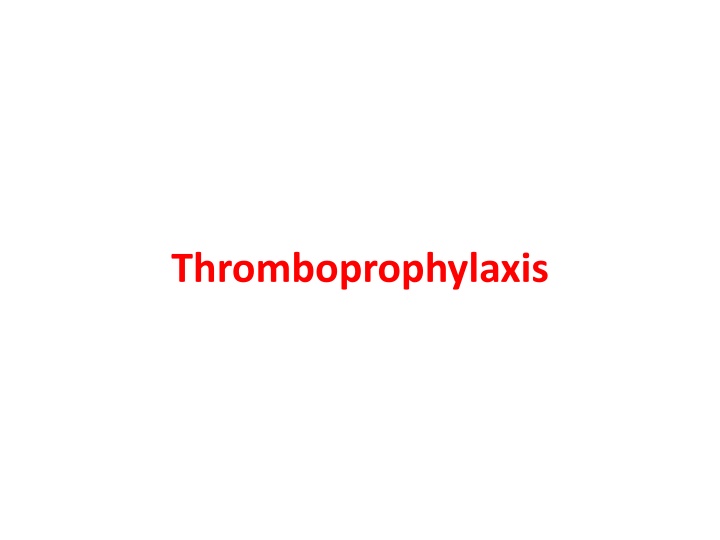
Thromboprophylaxis and Aspiration Pneumonia Prophylaxis in Surgery
Learn about thromboprophylaxis to prevent deep vein thrombosis in surgical patients over 40 years old. Understand the risk groups and types of prophylactic measures including mechanical devices and drugs. Explore preoperative prophylaxis measures against aspiration pneumonia for high-risk patients. Discover pharmaceutical care for patients with risk factors like obesity, DM, and trauma to prevent aspiration pneumonitis.
Download Presentation

Please find below an Image/Link to download the presentation.
The content on the website is provided AS IS for your information and personal use only. It may not be sold, licensed, or shared on other websites without obtaining consent from the author. If you encounter any issues during the download, it is possible that the publisher has removed the file from their server.
You are allowed to download the files provided on this website for personal or commercial use, subject to the condition that they are used lawfully. All files are the property of their respective owners.
The content on the website is provided AS IS for your information and personal use only. It may not be sold, licensed, or shared on other websites without obtaining consent from the author.
E N D
Presentation Transcript
Deep venous thrombosis (DVT) is most common in patients over 40 years of age who undergo major surgery. A postoperative increase in platelets coupled with venous endothelial trauma and stasis all contribute . If no prophylaxis is given, 30% of these patients will develop DVT and 0.1-0.2% will die from pulmonary thromboembolism (PTE)
Types of thromboprophylaxis(1). 1-Mechanical devices :Thromboembolic deterrent stockings (TEDS). 2-Drugs acting on the clotting cascade :Heparin and Low molecular weight heparin (LMWH). Regimen : heparin 5000U SC 2h pre-op, then every 8-12h SC for 7d or until ambulant. Low molecular weight heparin (LMWH) may be better (less bleeding, no monitoring needed).: eg enoxaparin 20mg/d SC, increased to 40mg/d in major-risk surgery (2). Fondaparinux (a factor Xa inhibitor) and ximelagatran may be better than LMWH .(2).
Risk groups (1). All patients are -at risk of developing deep vein thrombosis just as is the general population. Certain factors increase this risk and warrant specific interventions. It is usual to divide patients according to estimated risk. 1-Low risk (TEDS only) Day case surgery, minor orthopaedic procedures, and surgery after which patients mobilize immediately.
2-Medium risk (TEDS and prophylactic dose LMWH) Examples include minor surgery where mobilization is expected to be slow; abdominal, thoracic, upper limb orthopaedic surgery; low risk procedures with associated comorbid risk factors (diabetes, obesity, cardiorespiratory disease, malignancy, oral contraceptive pill, previous history of thromboembolic disease). 3-High risk (TEDS and treatment dose LMWH or IV heparin) Examples include pelvic surgery, major lower limb orthopaedic procedures, surgery for malignancy, medium risk procedures with associated comorbid risk factors (diabetes, obesity, cardiorespiratory disease, malignancy, oral contraceptive pill, previous history of thromboembolic disease).
Obesity, DM, pregnancy, peptic ulcer, stress, elderly, pediatric, trauma and emergency surgery are risk factors which may lead to delayed gastric emptying, increase gastric volume, and decrease esophageal sphincter result in regurgitation and aspiration of gastric contents causing potentially fatal condition called aspiration pneumonitis, therefore such patient require special pharmaceutical care to prevent aspiration by:
A- Antacid agents: they should be given as a single dose 30 ml approximately 15-30 min before induction of anesthesia, antacids has two major advantages: 1-Rapid onset of action . 2-Effective on the fluid already present in the stomach. The major disadvantages are: 1-Their effect may not last as long as the surgical procedure. 2-Their administration adds fluid volume to the stomach. B- Gastric motility stimulants (prokinetic agents) They act by promoting gastric emptying therefore reducing gastric volume, these agents should be given 60min before induction of anesthesia when given orally, 30min when given IV.
C- H2 receptor antagonists They act by reducing gastric acidity and volume by inhibition of gastric secretion.H2 blockers has no action on gastric contents already present in the stomach therefore oral dose of H2 blockers is given at the evening before surgery followed by an oral or parenteral dose on the morning of surgery, these agents do not produce an immediate effect. D- Proton pump inhibitors They are effective in suppressing acid secretion .
















